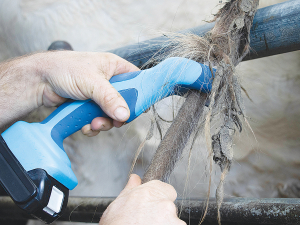Halter goes global, but NZ farmers remain core to innovation
Virtual fencing company Halter is going global but for founder Craig Piggott, New Zealand farmers will always remain their main partners.
 The Switch tail trimmer is not only ergonomically designed to cows’ tails but also reduce the risk of repetitive strain injury in users.
The Switch tail trimmer is not only ergonomically designed to cows’ tails but also reduce the risk of repetitive strain injury in users.
Any dairy farmer who has taken a smack in the face from a dung-encrusted cow’s tail on a frosty morning will know the feeling and wonder how to stop it happening again.
With tail docking banned since October 2018, tail trimming has become more popular. However, frustrations still abound as traditional clippers are not particularly suited to removing dags or matted hair. Firstly, because these were probably designed for removing wool from a sheep’s back; secondly, because they are quite heavy.
Lisa Newman, a farmer’s daughter from New Plymouth and a student at Massey University, was very familiar with the problem. So she set out to design a dedicated trimmer that was suited to the conformation of the cow and also friendly for the operator.
Extensive initial research within the dairy industry, which also involved speaking with veterinarians and animal care specialists, confirmed the need. But she also went on to look at a wide range of animal sizes, alongside shed design and working environments.
Newman’s design, Switch, is the only device that is ergonomically designed to trim cows’ tails – as well as reduce the risk of repetitive strain injury in users. Currently a design concept, it is at a stage where discussions with potential manufacturers regarding commercialisation are happening. It was also an entrant in the Fieldays Innovation Awards and recently took out a James Dyson design award.
Featuring clipper blades that mimic the profile of a cow’s tail, so trimming more area each pass than a traditional flat trimmer. With the outer blade oscillating over an inner fixed blade, there is reduced risk of injury to the animal and the user.
Power is provided by an 18 volt/1.5Ah lithium-ion battery that testing suggests should have a 2-hour run time. Weighing in at 1.5kg, that weight is counterbalanced to take away the potential for RSI. Meanwhile, the cutting head is inclined at 40 degrees to keep the user’s wrist in a more natural position.
The on/off switch is situated on the top face of the unit, allowing users to use the device in any position that feels more comfortable.
“Regular tail trimming helps promote better animal health and well being by keeping the animals’ cleaner at the back end and especially around the udder and teats,” Newman explains.
“It also helps reduce the risk of an animal from losing a part of its tail, as blood vessels become constricted by dried faecal matter and can result in self-docking.”
She says Switch is effective and easy to use.
“I also hope it will encourage farmers to move to tail trimming, rather than continue with the illegal practice of tail docking.”
According to the latest Federated Farmers banking survey, farmers are more satisfied with their bank and less under pressure, however, the sector is well short of confidence levels seen last decade.
Farmer confidence has taken a slight dip according to the final Rabobank rural confidence survey for the year.
Former Agriculture Minister and Otaki farmer Nathan Guy has been appointed New Zealand’s Special Agricultural Trade Envoy (SATE).
Alliance Group has commissioned a new heat pump system at its Mataura processing plant in Southland.
Fonterra has slashed another 50c off its milk price forecast as global milk flows shows no sign of easing.
Meat processors are hopeful that the additional 15% tariff on lamb exports to the US will also come off.

OPINION: The release of the Natural Environment Bill and Planning Bill to replace the Resource Management Act is a red-letter day…
OPINION: Federated Farmers has launched a new campaign, swapping ‘The Twelve Days of Christmas’ for ‘The Twelve Pests of Christmas’ to…